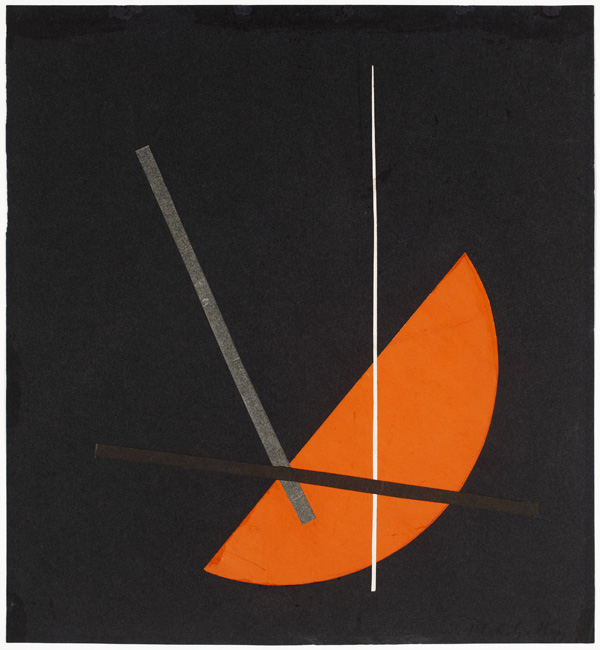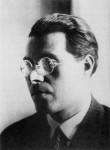
László Moholy-Nagy
Hungarian, 1895-1946 (active Germany, England and USA)
Composition, 1922-23
paper collage on paper
12 x 11 in.
SBMA, Gift of Charlotte Mack
1953.34.5

Portrait of László Moholy-Nagy, 1926, by Lucia Moholy
“One can never experience art through descriptions. Explanations and analyses can serve at best as intellectual preparation. They may, however, encourage one to make a direct contact with works of art.” — László Moholy-Nagy, The New Vision (12)
RESEARCH PAPER
László Moholy-Nagy, a recognized Bauhaus teacher in both Germany and the United States, is known for his experimentations using new, especially industrial materials in creating art, and for the photogram, a camera-less process he developed for making shadowy, translucent photographs. However, before these innovations he was an artist very much influenced by early 20th-century social as well as artistic developments in Europe, especially Suprematism and Constructivism.
Suprematism, developed by Kasimir Malevich (1879-1935), was interested in the feelings elicited by pure geometric shapes, especially the square and the circle; the power of abstract art should come from “the supremacy of pure feeling in creative art” and not from the visual aspects of a work (Malevich, 67). Constructivism, conceived by Vladimir Tatlin (1885-1953) and expanded by El Lissitzky (1890-1941), also employed non-representational geometric shapes but in conjunction with new, industrial materials in ways that the art had functionality; the end of all art—crafts, architecture, theater, music, industrial design, as well as the fine arts—was to improve life, to elevate society. Moholy was familiar with Malevich’s work, and in 1921 in Berlin he met and worked with Lissitzky, a former student of Malevich.
Moholy began dabbling in Constructivism’s tenets in the very early 1920s at about the same time he began experimenting with industrial materials, particularly painting on plastic. He was concerned with the emotional impact of the basic blocks of abstract art: “I discovered that ‘composition’ is directed by an unconscious sense of order in regard to the relations of color, shape, position, etc., and often by a geometrical correspondence of elements” (Abstract, 71).
The Constructivists debated the difference between construction and composition in 1921 at the Institute of Artistic Culture (INKhUK) in Moscow. Moholy added his own distinction: a “composition” relied on the artist’s subjective, aesthetic, and perceptive judgments; a “construction”, on the other hand, was the pre-determined result of the artist’s rational use of his intellect and technology to create a specific objective. Any change in process would destroy the objective of a construction, but a procedural change would only alter the appearance of a composition, not necessarily the intended impact. (See New Vision, 31, and Margolin, 15)
In his new experiments Moholy used a very dark plastic material, and to examine the visual and emotional impact of his abstractions, he manipulated geometric cutouts on black paper until he was satisfied with the result. “Composition” (ca. 1922-23) in the permanent collection of the Santa Barbara Museum of Art is one of these experimental collages on paper which invites our personal interpretations.
At its basic level “Composition” (ca 1922-23) is a radial composition of intersecting lines enhanced by a circle segment that creates a focal point and contributes to the structure with both its straight and curved lines. However, to approach this composition as Moholy defined it (see above), ones subjective response might find much more than a simple grouping of lines and shapes but instead see motion, tension, opposition, and harmonic resolution.
The dominant, bright circle segment against the black paper support demands our attention. With its singularity, the curve of the form confronts all of the other lines, including the edges of the paper, and seduces our eye to be attentive and not wander off the picture plane. At the same time it directs our eye to the top of the free-hand, perpendicular white line which interjects the human touch in what otherwise is a composition of rigid, hard-edge forms. The thinness at the top of the line yields to the heavier base, persuading the viewer to examine the dark, diagonal form, which is more rectangular than linear. Where they meet, the lightest and darkest elements forms a cross with all of its emotional associations. The two linear rectangles intersect on the edge of the straight edge of the circle segment—a junction of the darker, cooler diagonal elements with the warm, hot circular segment.
Moholy was interested in the relationships of opposite or contrasting elements, particularly as they contributed to achieving “a natural balance of intellectual and emotional power” (New Vision, 15). In “Composition” (ca. 1922-23) what first appears to be a fairly static composition is full of implied movement and conflict as the separate elements resonate with each other and with the viewer, whose initial curiosity is rewarded by examining the syntax of this geometric language and discovering the balance obtained with these disparate yet surprisingly compatible elements.
Moholy’s geometric abstractions were meant to be non-representational, non-symbolic, and non-narrative works. His art is the art of design and feeling, and Moholy’s collages are attempts to reach a harmonious unity and not something with inherent, objective meaning. The artist was interested in the viewers’ emotional response to his work and believed “that mathematically harmonious shapes, executed precisely, are filled with emotional quality, and that they represent the perfect balance between feeling and intellect” (Abstract, 80). He thought that abstract art “creates new types of spatial relationships, new inventions of forms, new visual laws—basic and simple—as the visual counterpart to a more purposeful, cooperative human society” (Abstract, 76). Art and society are intrinsically linked. Joyce Tsai eloquently summarizes his vision:
“For Moholy, the most effective means of reaching the masses was by reconfiguring the senses to enable a new perception of historical and political conditions. According to this logic, human beings must first learn to perceive relationships within a work of art and become attuned to the ways in which subtle shifts in color, form, and space might fundamentally alter the balance of a composition. In this process, the newfound ability to discern formal relationships might expose the mutability of other kinds of relationships in the world—political, economic, and social.” (Tsai, 25-26)
Moholy was an enormously influential artist and teacher from the 1920s until his death, despite his unremarkable beginnings. László Weisz was born in Hungary in 1895 and later took Moholy-Nagy as his surname (from the town name where he grew up and the name of a lawyer friend who helped support the family). After service in the Austro-Hungarian army he enrolled in art school, ultimately moving to Vienna and then to Berlin. In 1922 Walter Gropius (1883-1969), founder of the Bauhaus, named Moholy to the faculty of the school where he taught the crucial introductory course (“vorkurs”) as well as classes in sculpture, painting, printmaking, typography, and design. He effectively moved the school closer to its original mission of integrating art and industry, but he did not advocate a rigid course of instruction. He aimed to develop the students’ curiosity as well as creativity:
“To reach this objective [of striving for the closest connection between art, science, and technology] one of the problems of Bauhaus education is to keep alive in grown-ups the child’s sincerity of emotion, his truth of observation, his fantasy and his creativeness.” (New Vision, 11)
Moholy resigned from the Bauhaus in 1928 and began a successful career as a free-lance designer in multiple media. With the rise of the Nazi party, he moved to London where he continued with various design jobs. In 1936 he designed special effects for Hungarian producer Alexander Korda’s science fiction film “Things to Come”. The following year he moved to Chicago to become the director of the New Bauhaus. The school failed to attract sufficient financial backing and closed within a year, but Moholy opened his own School of Design in 1939, later becoming the Institute of Design. Moholy-Nagy died in 1946, three years before the school became part of the Illinois Institute of Technology.
Moholy recognized the challenges of abstract art early in his career:
“As a young painter I often had the feeling, when pasting my collages and painting my ’abstract’ pictures, that I was throwing a message, sealed in a bottle, into the sea. It might take decades for someone to find and read it.” (Abstract, 76)
Seven decades after Moholy-Nagy wrote that sentiment, we are still challenged to interpret his message and read the beauty of his “’abstract’ pictures”.
Prepared for the Santa Barbara Museum of Art Docent Council by Ralph Wilson, 2015.
BIBLIOGRAPHY
MONOGRAPHS
Kandinsky, Wassily. “Point and Line to Plane: contribution to the analysis of the pictorial elements.” Translated by Howard Dearstyle and Hilla Rebay. New York: Solomon R. Guggenheim Foundation, 1947. Original title “Punkt und Linie zu Fläche”, 1926, Bauhaus Books, edited by Walter Gropius and L Moholy-Nagy. [https://archive.org/details/pointlinetoplane00kand]
Kaplan, Louis. “Laszlo Moholy-Nagy, Biographical Writings”. Durham (North Carolina) and London: Duke University Press, 1995. [http://monoskop.org/images/2/29/Kaplan_Louis_Laszlo_Moholy-Nagy_Biographical_Writings.pdf]
Malevich, Kazimir. “The Non-Objective World: The Manifesto of Suprematism” [1926]. Mineola, NY: Dover Publications, 2003.
Margolin, Victor. “The Struggle for Utopia: Rodchenko, Lissitzky, Moholy-Nagy, 1917-1946”. Chicago: University of Chicago Press, 1997.
[https://books.google.com/books?id=q93LHoimzjcC&printsec=frontcover&dq=victor+margolin+struggle+for+utopia&hl=en&sa=X&ei=g7WBVaOBGMHDsAWQ84PgCA&ved=0CCwQ6AEwAA#v=onepage&q=victor%20margolin%20struggle%20for%20utopia&f=false]
Moholy-Nagy, László. “The New Vision and Abstract of an Artist”. New York: Wittenborn, Schultz, Inc., 1947.
Néret, Gilles. “Kazimir Malevich, 1878-1935, and Suprematism”. Cologne, Germany: Taschen GmbH, 2013.
CATALOGS
Kuh, Katherine. “Moholy-Nagy in Chicago” in “L. Moholy-Nagy, An Exhibition sponsored by The Society for Contemporary American Art” [Moholy-Nagy Memorial Exhibition]. Chicago: Art Institute of Chicago, 1947. [http://www.artic.edu/sites/default/files/libraries/pubs/1947/AIC1947LMNagy_comb.pdf]
Tsai, Joyce. “The Paintings of Mololy-Nagy, The Shape of Things to Come”. With contributions by Larry J. Feinberg, Eik Kahng, James Merle Thomas and Friederike Waentig. Santa Barbara, California: Santa Barbara Museum of Art, 2015.
PERIODICALS
Filler, Martin “The Powerhouse of the New.” New York Review of Books, 24 June 2010. [http://www.nybooks.com/articles/archives/2010/jun/24/powerhouse-new/]
Gibson, Stephanie.(2010) “Laszlo Moholy-Nagy: Painting and Bio-politics” (Unpublished Bachelor of Arts thesis). Emory University College of Arts and Sciences, Druid Hills, Georgia. [https://etd.library.emory.edu/view/record/pid/emory:bq9sw]
Glueck, Grace. “Art: Kandinsky ‘s Russian and Bauhaus Year.” New York Times, 9 December 1983. [http://www.nytimes.com/1983/12/09/arts/art-kandinsky-s-russian-and-bauhaus-year.html]
Mac Carthy, Fiona — “The Fiery Stimulator.” The Guardian, 18 March 2006. [http://www.theguardian.com/artanddesign/2006/mar/18/art.modernism]
Mindrup, Matthew: “Translations of Material to Technology in Bauhaus Architecture”. Wolkenkuckucksheim, Internationale Zeitschrift zur Theorie der Architektur. Vol. 19, Issue 33, 2014, 161-172. [http://cloud-cuckoo.net/fileadmin/issues_en/issue_33/article_mindrup.pdf]
Sartori, Andreza, Victoria Yanulevskaya, Almila Akdag Salah, Jasper Uijlings, Elia Bruni, and Nicu Sebe. “Affective Analysis of Professional and Amateur Abstract Paintings Using Statistical Analysis and Art Theory”. ACM Transactions on Interactive Intelligent Systems, Vol. V, No. N, Article A, Pub. date: January YYYY [2015?]. Pp. A:1 – A:27. Pre-publication article. [http://www.huppelen.nl/publications/2015SartoriAffectiveAnalysisOfArtworks.pdf]
WEBSITES
Constructivism — http://www.theartstory.org/movement-constructivism.htm
El Lissitzky — http://en.wikipedia.org/wiki/El_Lissitzky
László Moholy-Nagy — http://monoskop.org/L%C3%A1szl%C3%B3_Moholy-Nagy#Early_years
The Moholy-Nagy Foundation — http://moholy-nagy.org/about/biography2/
Smithsonian American Art Museum — http://americanart.si.edu/collections/search/artist/?id=3371
Rekveld, Joost. PDF with excerpts from “Vision in Motion” by LaszloMoholy-Nagy, “Moholy-Nagy, an anthology” by Richard Kostelanetz (ed.), and “The New Landscape in Art and Science” by Gyorgy Kepes (ed.). [http://rekveld.home.xs4all.nl/tech/Moholy_Kepes_fragments.pdf]
Suprematism — http://en.wikipedia.org/wiki/Suprematism
Wassily Kandinsky — http://en.wikipedia.org/wiki/Wassily_Kandinsky#Bauhaus_.281922.E2.80.931933.29
PHOTOGRAPH
Lucia Moholy, Portrait of László Moholy-Nagy, 1926 — Bauhaus-Archiv Berlin
[http://bauhaus-online.de/en/atlas/personen/laszlo-moholy-nagy]
